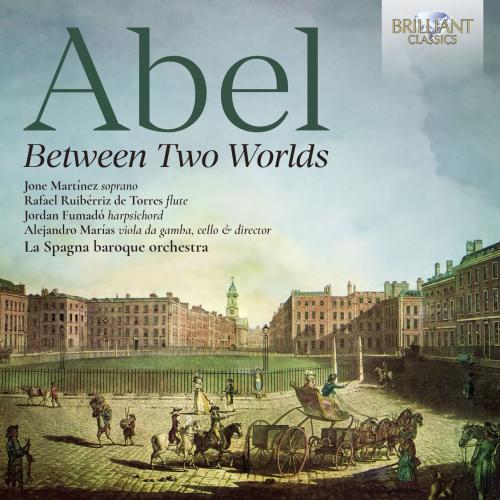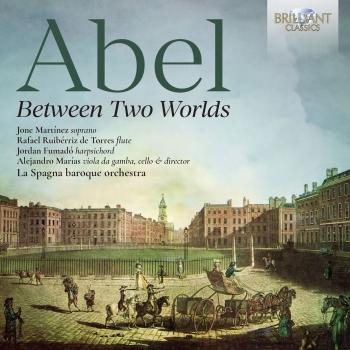
Abel: Between two Worlds La Spagna
Album info
Album-Release:
2024
HRA-Release:
27.09.2024
Label: Brilliant Classics
Genre: Classical
Subgenre: Vocal
Artist: La Spagna
Composer: Carl Friedrich Abel (1723-1787)
Album including Album cover
- Carl Friedrich Abel (1723 - 1787): Symphony in C Major, Op. 10 No. 4, AbelWV E22:
- 1 Abel: Symphony in C Major, Op. 10 No. 4, AbelWV E22: I. Presto 03:58
- 2 Abel: Symphony in C Major, Op. 10 No. 4, AbelWV E22: II. Andante 02:44
- 3 Abel: Symphony in C Major, Op. 10 No. 4, AbelWV E22: III. Allegro 02:17
- Aria "Frena le belle lagrime" from Sifari, AbelWV A8:
- 4 Abel: Aria "Frena le belle lagrime" from Sifari, AbelWV A8 11:28
- Concerto Flauto Traverso Concertato in E Minor, AbelWV F14:
- 5 Abel: Concerto Flauto Traverso Concertato in E Minor, AbelWV F14: I. Allegro 05:44
- 6 Abel: Concerto Flauto Traverso Concertato in E Minor, AbelWV F14: II. Adagio 04:24
- 7 Abel: Concerto Flauto Traverso Concertato in E Minor, AbelWV F14: III. Allegro 04:08
- Concerto Viola de Gamba in A Major, AbelWV A9:1A:
- 8 Abel: Concerto Viola de Gamba in A Major, AbelWV A9:1A: I. Allegro Moderato 04:29
- 9 Abel: Concerto Viola de Gamba in A Major, AbelWV A9:1A: II. Adagio 05:11
- 10 Abel: Concerto Viola de Gamba in A Major, AbelWV A9: A: III. Allegro 03:45
- Concerto a Cembalo obligato in D Major, AbelWV F7:
- 11 Abel: Concerto a Cembalo obligato in D Major, AbelWV F7: I. Moderato 06:38
- 12 Abel: Concerto a Cembalo obligato in D Major, AbelWV F7: II. Adagio 06:16
- 13 Abel: Concerto a Cembalo obligato in D Major, AbelWV F7: III. Allegro Assai 05:22
- Concerto a Viola da Gamba Concertata in G Major, AbelWV A9:2:
- 14 Abel: Concerto a Viola da Gamba Concertata in G Major, AbelWV A9:2: I. Moderato 05:43
- 15 Abel: Concerto a Viola da Gamba Concertata in G Major, AbelWV A9:2: II. Adagio ma non Troppo 05:18
- 16 Abel: Concerto a Viola da Gamba Concertata in G Major, AbelWV A9:2: III. Allegro 04:57
Info for Abel: Between two Worlds
There are many reasons to consider Carl Friedrich Abel (1723–1787) one of history’s most unique musicians. He was a gambist, a player of an instrument long associated with an aristocracy that was then at the height of its decadence. But today he would be labelled “avantgarde” as one who embraced the newest musical styles and indeed genres, playing a key role in the development of the symphony.
This album opens with the Symphony in C from his Opus 10 set of six symphonies. Featuring an instrumentation of two oboes, two horns, two violins, viola and basso, the score has all the hallmarks of the era’s symphonic music. Abel’s only vocal work of note is the aria “Frena le belle” which he contributed to the pastiche opera Sifare. So inspiring is the music, it is regrettable that Abel did not find greater repute in the vocal repertoire. Abel’s updated catalogue (AbelWV, publ. Günter von Zadow, 2023) includes 420 works, of which 29 are concertos for solo instruments.
These follow the typical pattern, with three movements (first and third played fast in the home key, the second more slowly in a separate albeit related key) starting and ending in orchestral ritornellos, which are also interposed between each solo. That notwithstanding, the Flute Concerto in E minor has a very particular structure consisting of three movements all in minor keys.
The viola section was reconstructed by Wolfgang Kostujak. The Harpsichord Concerto in D Güntersberg, 2022) derives from a manuscript produced by two unidentified copyists. This score, bearing an Italian title without reference to the pianoforte, suggests it was composed while Abel was still in Germany. Of the numerous concertos Abel himself performed as solo gambist during his life in London, tragically, none remain. The two on this album (Güntersberg) therefore merit some explanation.
The Concerto in A comes to us from an unfinished manuscript by an unknown copyist, with no mention of the work’s composer, but a comprehensive analysis of the music has led Thomas Fritzsch to attribute it to Abel. Kostujak has reconstructed the parts for first and second violins, viola, and a few passages for basso. The Concerto in G is none other than the Cello Concerto in B flat, in turn the same as the Flute Concerto in C. Such repurposing of works is not exceptional in Abel’s catalogue, and a detailed analysis provides ample evidence that this was intended for viola da gamba in the original version.
Jone Martinez, soprano
Rafael Ruiberriz de Torres, flute
Jordan Fumado, harpsichord
Alejandro Marias, viola da gamba, cello & director
La Spagna Baroque Orchestra
La Spagna
The La Spagna ensemble, which takes its name from one of the most famous melodies of the Renaissance, was founded by Alejandro Marías in 2009 by bringing together some of the best historically informed musicians of his generation. With a very flexible format, it has two aspects, as a chamber group and as a baroque orchestra, with which it performs opera and oratorio together with guest soloists and conductors.
The styles tackled by La Spagna range from the Renaissance to the early Romanticism —with some foray into 21st century music—, although most of its activity focuses on the Baroque. This diversity always revolves around the same principle: to offer a passionate, trustworthy and sincere interpretation that respects the historical and social perspective of each repertoire.
Since the publication of their album A Tribute to Telemann, La Spagna has recorded the works for viola da gamba by Jacques Morel (Brilliant Classics) and Las Siete Palabras by Haydn-Barbieri. In recent times, the group has performed in places such as the Symphonic Hall of the National Music Auditorium, the Royal Palace or the Congress of Deputies, as well as in the Seville Festival de Música Antigua, Santander Festival, the Festival Internacional de Arte Sacro or the Festival de Música Española of Cádiz. Upcoming projects include a European tour presenting the latest album and collaboration with current composers with the aim of creating new repert
Jone Martínez
from Sopelana, Basque Country, began her musical learning at the Leioa Conservatory, singing in the children's choir and studying guitar, before beginning her lyrical singing studies with Olatz Saitua at the Juan Crisóstomo de Arriaga Conservatory in Bilbao.
In 2013, she obtained a degree in Musical Language Pedagogy and Music Education at Musikene, Conservatorio Superior de Música del País Vasco, where she is currently completing her studies in lyrical singing with Maite Arruabarrena (vocal technique) and Maciej Pikulski (interpretation and repertoire). She is also furthering her training with Carlos Mena, with whom she specialises in early music.
Parallel to her activity as a vocal technique teacher and choir assistant with Basilio Astulez, Jone Martínez began a rapid career as a soloist singer. Her vocal and artistic qualities have been appreciated by important conductors with whom she has sung the soloist parts in numerous Renaissance, Baroque and Classical works both in Spain and abroad, in cities such as London, Cambridge and even Hong Kong. She is a regular soloist with Conductus Ensemble and Capilla Santa María and also collaborates with Soinuaren Bidaia and other specialised groups such as Musica Ficta, Quondam and Capilla Michael Navarrus. She has recently sung with the Orquesta Sinfónica de Burgos, the Orquesta Barroca de Sevilla and performed the soloist role in Handel's Messiah under the baton of Carlos Mena and the Orquesta Sinfónica de Galicia. She has performed in the Semana de Música Religiosa de Cuenca and in the Semana de Música Antigua de Estella on several occasions.
This album contains no booklet.











